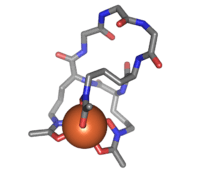Ferrichrome
Not to be confused with ferrochrome.
 Ferrichrome (sticks) bound to an iron atom (orange) | |
| Names | |
|---|---|
| IUPAC name
N-[3-[4,16-bis[3-[acetyl(oxido)amino]propyl]-2,5,8,11,14,17-hexaoxo-3,6,9,12,15,18-hexazacyclooctadec-1-yl]propyl]-N-oxidoacetamide; iron(3+) | |
| Identifiers | |
| 15630-64-5 | |
| 3D model (Jmol) | Interactive image |
| ECHA InfoCard | 100.036.081 |
| PubChem | 27424 |
| |
| Properties | |
| C27H42FeN9O12 | |
| Molar mass | 740.52 g/mol |
| Except where otherwise noted, data are given for materials in their standard state (at 25 °C [77 °F], 100 kPa). | |
| | |
| Infobox references | |
Ferrichrome is a cyclic hexa-peptide that forms a complex with iron atoms. It is a siderophore composed of three glycine and three modified ornithine residues with hydroxamate groups [-N(OH)C(=O)C-]. The 6 oxygen atoms from the three hydroxamate groups bind Fe(III) in near perfect octahedral coordination.
Ferrichrome was first isolated in 1952, has been found to be produced by fungi of the genera Aspergillus, Ustilago, and Penicillium.[1]
References
- ↑ Ferrichrome, Virtual Museum of Minerals and Molecules, University of Wisconsin
This article is issued from Wikipedia - version of the 7/7/2015. The text is available under the Creative Commons Attribution/Share Alike but additional terms may apply for the media files.